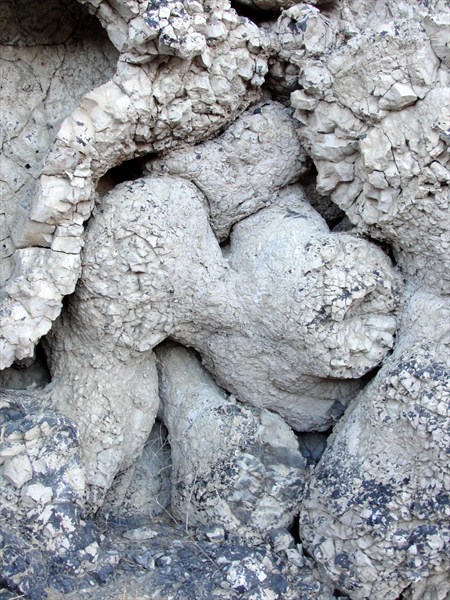To get to this earthcache, we suggest you park at the parking waypoint coordinates. The hiking distance is over 2 miles round trip. You can also park at the Quincy Lakes and hike down the coulee, but the terrain rating will be higher because of about a 450 foot elevation change during the hike. You will need a WA Discover Pass to park at the designated area or in the parking areas above the coulee at the Quincy Lakes.
The posted coordinates are located on a trail on the south side of the Ancient Lakes Basin of the Potholes Coulee near Quincy, Washington. If you look south from this point, the rock outcrop displays a nice example of pillow lava.
 The bulbous pillows are stacked on one another, sometimes looking a little like twisted toothpaste.
The bulbous pillows are stacked on one another, sometimes looking a little like twisted toothpaste.
Pillow lava forms when molten lava flows under water forming a series of pods. The water cools and solidifies the exterior of lava to form a pod. Most of the pods split and the lava flows through the split to form the next pod.
To get a close up look at the pillow lava, there is a short, but slightly steep slope to climb. From up close, you can see a lot of interesting details in the pillow lava. Please be careful climbing up the slope because of loose rock.
The basalt that forms the pillow lava is part of a layer called the Frenchman Springs Member which is part of the Columbia River Basalt. The basalt in this layer is about 15.5 million years old. The pillow lava may have formed when lava flowed into the ancestral Columbia River.

Pillow lava forming underwater
Off the coast of Hawaii
Still photo from the movie "Pele Meets the Sea"
To see video footage click here
 To get credit for this earthcache:
To get credit for this earthcache:
Send me an e-mail with the answers to the following questions. (NOTE: Do not post the answers in your log or it will be deleted.)
- What is the approximate length and diameter of the "pillows"?
- One of the pillows has a large open cavity that is wide at the top and narrow at the bottom. How do you think this cavity formed?
- Look at the fractures (cracks in the rocks) in the pillow lava and compare them to the fractures you can see in the basalt in the tall cliffs behind the pillow lava outcrop. How are they different?
A picture of you at the location would be fun, but is not required.
A second location where you can see another outcrop of pillow lava is nearby at N47 08.817, W 119 57.658.
Congratulations to Mr. Gadget #2 for the FTF!
Source:
Bjornstad, Bruce (2004), Potholes Coulee, Geocaching.com, Geocache GCKT9Z.
Carson, Robert J.; Pogue, Kevin R. (l996), Flood Basalts and Glacier Floods: Roadside Geology of Parts of Walla Walla, Franklin, and Columbia Counties, Washington, Washinton State Department of Natural Resources (Washington Division of Geology and Earth Resources Information Circular 90)
